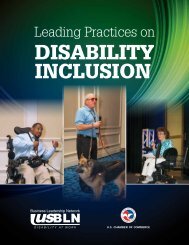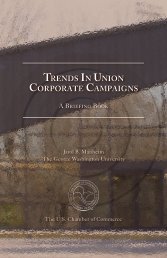AUDITING - US Chamber of Commerce
AUDITING - US Chamber of Commerce
AUDITING - US Chamber of Commerce
Create successful ePaper yourself
Turn your PDF publications into a flip-book with our unique Google optimized e-Paper software.
<strong>AUDITING</strong>: A PROFESSIONAT RISKU.S. <strong>Chamber</strong> <strong>of</strong> <strong>Commerce</strong>January 2006
<strong>AUDITING</strong>: A PROFESSIONAT RISKU.S. <strong>Chamber</strong> <strong>of</strong> <strong>Commerce</strong>January 2006
<strong>AUDITING</strong>: A PROFESSIONAT RISKAuditing plays a unique role in oureconomy. By law, all companies whosesecurities are available to the general publicthrough U.S. exchanges are required tohave their financial statements auditedby an independent registered publicaccounting firm. The goal has historicallybeen to provide confidence to investorsand bring standardization and discipline tocorporate accounting, thereby increasingthe liquidity and economic potential <strong>of</strong>U.S. capital markets.While there are legitimate debates aboutthe meaning <strong>of</strong> financial statement audits,there are certain facts about the auditingpr<strong>of</strong>ession that are hard to deny:• Not only is auditing required by law,but recent regulations and legislation(most notably the Sarbanes-OxleyAct <strong>of</strong> 2002) greatly increased its rolein public companies. The politicaldetermination has been made thatauditing is central to public confidencein our capital markets.• The pressure for auditors to “do more”when conducting audits means that theauditor-client relationship is becomingmore involved and continuous, withmuch more frequent interactions,rather than simply holding periodic3
Auditing: A Pr<strong>of</strong>ession at Risk4discussions geared around financialstatement reporting cycles.• The auditing pr<strong>of</strong>ession faces a number<strong>of</strong> significant legal challenges. It issubject to new regulation under theauspices <strong>of</strong> the Public CompanyAccounting Oversight Board (PCAOB).More important, the pr<strong>of</strong>essionfinds itself the target <strong>of</strong> a difficultlitigation and regulatory enforcementenvironment, where business lossesby a client can result in lawsuits, anda single indictment — even withouta conviction — can result in thedestruction <strong>of</strong> thousands <strong>of</strong> jobs.• Because <strong>of</strong> the Sarbanes-Oxley Act andother requirements, auditing expenseshave increased tremendously. At thesame time, many clients believe thatthey are receiving less overall adviceand support from their auditors. Auditfirms feel that they are caught in ano-win situation between the demands<strong>of</strong> regulators, law enforcement, theplaintiffs’ bar, and their clients.• The process <strong>of</strong> developing accountingprinciples remains in flux, evenas business transactions becomeever more complex. In addition tothe respective roles <strong>of</strong> FASB, thePCAOB, and the SEC, there are manyemerging issues related to internationalharmonization and the IASB.
Auditing: A Pr<strong>of</strong>ession at Risk• There remain significant misunderstandingsabout the meaning andnature <strong>of</strong> accrual accounting systemsand the level <strong>of</strong> precision inherent insuch systems. Changes <strong>of</strong> 1 or 2 centsper share in a company’s earnings canhave a great market impact — andcreate significant litigation risk — evenif such changes indicate nothing aboutthe health <strong>of</strong> a company’s underlyingbusiness.• The pr<strong>of</strong>ession — through voluntarymergers as well as through theelimination <strong>of</strong> Andersen — is severelycontracted, with only four major firmsserving a large majority <strong>of</strong> the listedand actively traded public companiesin the United States. While fourappears to be a sustainable number,any further contraction in this industrywould present a major challenge tothe viability <strong>of</strong> the pr<strong>of</strong>ession, withpotential for a negative effect on publicconfidence in our markets. WilliamMcDonough, former chair <strong>of</strong> thePCAOB, said, “None <strong>of</strong> us [regulators]has a clue what to do if one <strong>of</strong> the BigFour failed.” He also said that if one <strong>of</strong>the Big Four were to collapse, the bestaccountants could choose to quit thepr<strong>of</strong>ession 1 .There continue to be debates about therole that the auditing pr<strong>of</strong>ession itself hasplayed in bringing about some <strong>of</strong> these1Financial Times, September 28, 2005, p. 26.5
Auditing: A Pr<strong>of</strong>ession at Riskcircumstances, and what it can do on itsown to address the current challenges.Nevertheless, the simple facts are that(i) confidence and stability are critical tothe success <strong>of</strong> capital markets, and (ii)auditing helps bring these attributes to ourmarkets. Instead <strong>of</strong> risking a crisis, it isimportant to act now to try to bring somestability back to the auditing pr<strong>of</strong>ession.At the same time, action must be takento ensure that the needs <strong>of</strong> companiesare met and that they have access tohigh-quality, reasonably priced auditingservices.ACTION PLANThe U.S. <strong>Chamber</strong> <strong>of</strong> <strong>Commerce</strong> iscommitted to supporting policies thatenhance the value <strong>of</strong> audits and ensurethe long-term viability <strong>of</strong> the auditingpr<strong>of</strong>ession. In that regard, we propose thefollowing three-part action plan:6• Help the pr<strong>of</strong>ession become insurable• Clarify PCAOB standards• Support expansion <strong>of</strong> and competitionamong the Big Four firmsThis plan will require a broad-based effort,involving coordinated support amongpolicymakers, Wall Street, the auditingpr<strong>of</strong>ession, and the broader businesscommunity. The U.S. <strong>Chamber</strong> stands
Auditing: A Pr<strong>of</strong>ession at Riskready and willing to be at the center <strong>of</strong>these efforts.HELP THE PROFESSIONBECOME INSURABLEAuditing firms are required by statepr<strong>of</strong>essional licensing laws and ethicalrules to operate as partnerships that do notseek outside equity capital. As voluntaryorganizations funded by individual partners,auditing firms cannot be successful ifthere are concerns about their stability andsurvival. Clients and valuable partners can— and will — leave if these concerns arise.This is even more true at the internationallevel, where local affiliates can move wholenational practices at the first sign <strong>of</strong> trouble.Andersen is a perfect example <strong>of</strong> the damagethat can be done to a large, internationalconfederation <strong>of</strong> partnerships as a result <strong>of</strong>the actions <strong>of</strong> a few bad employees and oneill-considered indictment.While it would be neither possible nordesirable to limit all risks to the stability<strong>of</strong> auditing firms, there are particularconcerns about growing legal threats.Overlitigation and unfair enforcementthreaten many parts <strong>of</strong> our economy— and the <strong>Chamber</strong> has been at theforefront <strong>of</strong> efforts to bring rationalityback to our legal system. But pr<strong>of</strong>essionalpartnerships that can dissipate overnightare particularly vulnerable. Oneindictment or excessive judgment that7
Auditing: A Pr<strong>of</strong>ession at Riskjolts the confidence <strong>of</strong> clients or partnershas the potential to immediately destroyan audit firm, even if that indictment orjudgment is later overturned or reducedon appeal.Furthermore, these legal risks are souncertain — and their implications are sodire — that the pr<strong>of</strong>ession is effectivelyuninsurable. Without this standard toolfor business planning and protection, thepr<strong>of</strong>ession sits on a knife’s edge.This is not only bad for firms and theirclients, but it also makes the auditingpr<strong>of</strong>ession increasingly unattractive tohigh-quality personnel. Qualified auditorsface ever-growing incentives to exercisetheir pr<strong>of</strong>essional options and may opt toleave the pr<strong>of</strong>ession altogether.It is vital that we better define theresponsibilities and appropriate potentiallegal risks <strong>of</strong> the pr<strong>of</strong>ession and establishthe conditions that would allow forcommercial insurability and, therefore,stability. Part <strong>of</strong> the answer may involvetort reform. The U.S. <strong>Chamber</strong> Institutefor Legal Reform is the nation’s premieradvocate for bringing rationality back toour legal system, and we stand ready tosupport responsible options for bringingtort relief to the auditing pr<strong>of</strong>ession.However, even short <strong>of</strong> comprehensivetort reform, we believe that the followingfour initiatives could have a substantially8
Auditing: A Pr<strong>of</strong>ession at Riskpositive effect on the environmentsurrounding auditing:(i) Better define an auditor’s proceduresfor fraud detection and the limits <strong>of</strong>an auditor’s responsibilityAuditors are neither detectives norarms <strong>of</strong> law enforcement. They donot and should not have the abilityto issue subpoenas, establish wiretaps,or conduct lie detector tests. Theyare not trained in criminal law andcannot reasonably monitor thepersonal behavior <strong>of</strong> executives.Nonetheless, while auditors cannoteliminate the risk <strong>of</strong> fraud, they areinevitably blamed when it occurs— even when it is the auditor whoultimately uncovers the fraud. This isa standard that no law enforcementagency could meet. The increasingburdens on auditors for frauddetection result in increasing auditcost burdens on all clients.Auditors should neither be expectedto detect or prevent all cleverlydesigned collusive frauds, nor shouldthey necessarily be liable when suchfrauds occur. The auditing pr<strong>of</strong>essionaccepts and should continue toaccept some responsibility fordetecting fraud, but the limitationson this responsibility should beclearly defined. A clean audit opinionis not a guarantee that no fraud9
Auditing: A Pr<strong>of</strong>ession at Risk10has occurred — only evidence thatreasonable and thorough efforts havebeen made to detect fraud. In thatrespect, we recommend that thePCAOB promulgate a safe harborstandard for fraud detection, whichclearly defines the nature and extent<strong>of</strong> procedures that an auditing firmmust employ to detect fraud.A safe harbor would provide clarityto the investing public about themeaning <strong>of</strong> an audit opinion, andit would allow firms to determinewhen they have satisfied theirresponsibilities. Such a standardwould also protect auditing firmsfrom legal liability when thePCAOB-prescribed procedures havebeen reasonably performed.Without such a standard, auditingfirms are effectively asked to becriminal investigators and insurers <strong>of</strong>the character <strong>of</strong> corporate managers.This is not only unfair; it is alsoa strong disincentive for firms toaccept new and entrepreneurialclients with unproven management.The reluctance to accept suchclients places a significant burdenon the many innovative smallcompanies that are led by good, butunknown, managers. This ultimatelyundermines the future growth anddevelopment <strong>of</strong> the U.S. economy.
Auditing: A Pr<strong>of</strong>ession at Risk(ii) Create an ADR System for DisputesAbout AuditsThe U.S. <strong>Chamber</strong> supports alternativedispute resolution (ADR), particularlyfor industries where ADR wouldclearly be more efficient and fairer thannormal litigation procedures.Auditing is an example <strong>of</strong> a highlytechnical pr<strong>of</strong>ession where thestandards require the application <strong>of</strong>significant pr<strong>of</strong>essional judgment.It is simply not reasonable toexpect juries and nonexpertjudges to properly evaluate arcaneaccounting judgments and auditingmethodologies.There have been proposals forspecialized “accounting courts” foralmost 50 years. Whether throughthis or another proven ADRmechanism (such as mandatoryexpert arbitration), the <strong>Chamber</strong> callsupon the auditing pr<strong>of</strong>ession, thePCAOB, and Congress to establish acivil structure where disputes aboutaccounting issues are consideredand decided by experts with a deepunderstanding <strong>of</strong> the issues. Thereare areas where ADR may not makeproceedings more efficient or fairer— large and complex class actionsuits, for example — but certainlynot all audit disputes should end upin the courts.11
Auditing: A Pr<strong>of</strong>ession at Risk(iii) Permit Parties to Agree to ADR andto Reasonable Limits on LitigationThere have been calls for the SECand banking regulators to limit theability <strong>of</strong> auditing firms and theirclients to agree to ADR and tolimitations on punitive damages,among other things, as part <strong>of</strong> theirengagement negotiations. This is anattempt to deprive private parties <strong>of</strong>standard tools that are used in otherindustries to manage litigation riskand is clearly misplaced regulatoryoverreach. More litigation risk won’tmake for better audits; it will simplymake for more defensive audits.(iv) Regulate Threats <strong>of</strong> IndictmentAgainst FirmsAn auditing firm lives or dies by itsreputation, and a criminal indictmentcan immediately destroy a reputation,without regard to ultimate criminalculpability. The inappropriateindictment <strong>of</strong> Andersen led directly tosevere job dislocations for 28,000 peoplein the United States — and many tens<strong>of</strong> thousands overseas. This was wrong,unfair, and bad for our economy.12If crimes are committed, enforcementauthorities should indict and prosecuteindividuals involved in those crimes.This would include managers withknowledge <strong>of</strong> the criminal activity orwith responsibility for the operations
Auditing: A Pr<strong>of</strong>ession at Riskin which the activity took place. Otherindividuals with an interest in thefirm — who had no knowledge <strong>of</strong>the activity or any ability to affect it— should simply not be punished.Unfortunately, enforcementauthorities realize that indicting andprosecuting individuals is hard, whilethreatening to slap an indictmenton a pr<strong>of</strong>essional partnership is veryeasy. Audit firms cannot afford to beindicted, and they have very limitedmeans to defend themselves if accused<strong>of</strong> a crime. The mere threat <strong>of</strong> anindictment is a prosecutorial clubthat can produce guilty pleas andmonetary settlements — without theneed to prove any facts in a court <strong>of</strong>law. (This is not only a problem forauditing firms but for a wide range <strong>of</strong>enterprises in financial services andother industries.)We call upon Congress to rein in thismisused weapon <strong>of</strong> the Department<strong>of</strong> Justice and other regulatoryauthorities and to establish clearrules under which enterprises maybe criminally indicted, accordingto clear processes for having suchindictments carefully evaluated. Thegoal should be to acknowledge thedisparate impact indictments can haveon enterprises and the correspondingunchecked prosecutorial power.13
Auditing: A Pr<strong>of</strong>ession at Risk14Enterprises need a chance to beheard before indictments are handeddown — including an opportunityto object to the appropriateness <strong>of</strong> athreatened indictment in light <strong>of</strong> therespective roles <strong>of</strong> individuals versusthe institution.CLARIFY PCAOB STANDARDSAuditing Standard #2, the primaryimplementing standard for Section 404<strong>of</strong> Sarbanes-Oxley, is a large, expansive,principles-based document. While itprovides a great deal <strong>of</strong> room for auditorsto exercise judgment and to determinethe meaning <strong>of</strong> words like “significant”and “relevant,” it doesn’t provide muchguidance as to when “enough is enough”with respect to the auditing <strong>of</strong> internalcontrols. Auditors must be allowed toexercise pr<strong>of</strong>essional judgment, but thelack <strong>of</strong> specific guidance subjects themto substantial second guessing — by theplaintiffs’ bar, the inspection staff <strong>of</strong> thePCAOB, and others — that their auditsdid not go far enough.Senior PCAOB <strong>of</strong>ficials have stated thatthey can’t identify overauditing. If theprimary regulator doesn’t know the outerlimits <strong>of</strong> the standards, then how canaudit firms or their clients be expectedto? The PCAOB’s own inspection process— without a standard for determiningexcessive auditing — encourages auditors,
Auditing: A Pr<strong>of</strong>ession at Riskgiven their structure and liability risks, tocontinually exceed whatever anyone maythink is the standard for control testingand review.It is incumbent upon the PCAOB to stepin and define “enough,” at least in certainkey areas (such as IT systems), and leteveryone know the outer boundaries <strong>of</strong> whatis expected under Section 404. Further,even where “enough” cannot be reasonablydefined, the inspection process shouldbe used as a means to educate and revealreasonable limits, rather than to second guesspr<strong>of</strong>essional judgments.Overauditing, much like liability-inspired“defensive medicine,” exists and has beenthe cause <strong>of</strong> serious deterioration in manyauditor-client relationships. The PCAOBhas played a large role in creating thecircumstances for overauditing. It has theresponsibility to clarify Auditing Standard #2,provide reliable safe harbors, and bring theSection 404 cost-benefit equation backinto balance by allowing auditors and theirclients some measure <strong>of</strong> predictability andfreedom from second guessing.The business community is primarilyinterested in knowing that someone isultimately responsible for ensuring thatthe auditor-client relationship is healthyand productive. As the regulator for thispr<strong>of</strong>ession, it is incumbent upon the PCAOBto step up and accept this responsibility.15
Auditing: A Pr<strong>of</strong>ession at RiskSUPPORT EXPANSION ANDCOMPETITION AMONGTOP-TIER FIRMSIn the end, competition is the best wayto ensure good customer service. Giventhe small number <strong>of</strong> top-tier firms, manypublic companies feel that they have alimited ability to negotiate with auditorsabout fees or terms <strong>of</strong> service. In fact, acommon concern among smaller publiccompanies is being dropped by their longstandingauditing firms. These companiesbelieve that they have practically nonegotiating power.Many companies also hire other members<strong>of</strong> the Big Four for advisory and othernonaudit services that preclude thesefirms from bidding on audit work. Somelarge companies even have ongoingrelationships with all the Big Four.In order to <strong>of</strong>fer companies more choicein choosing an auditor and to increasecompetition among the Big Four,we call upon the SEC to reexaminethe regulations that prohibit the BigFour firms from competing for auditassignments when they have performeddisqualifying services in prior years. Amodification in this policy that allows forgreater flexibility and greater competitionamong the Big Four would enhance marketforces in the pr<strong>of</strong>ession and ultimatelybenefit our capital markets.16
Auditing: A Pr<strong>of</strong>ession at RiskIn addition to fostering greatercompetition among the top-tier firms,we need to remove nonmarket barriersimpeding competition with the Big Four.Unfortunately, there are no easy meansto that end, as there are tremendouslyhigh barriers for entry into this group. Itwould be unreasonable to try to expandthe group by unwinding previous mergers— no matter how those mergers mayappear in retrospect. In that same vein,a number <strong>of</strong> responsible commentatorshave said that mergers among second-tierfirms would be unlikely to create a trulycompetitive alternative to the Big Four.These and other methods could createmore weak firms, when what is needed aremore strong ones.Although the task <strong>of</strong> expanding the BigFour is difficult, it does not mean that it isimpossible or unimportant. We call uponthe SEC and the PCAOB, as well as theNew York Stock Exchange, NASDAQ,and FASB, to make long-term expansion<strong>of</strong> the Big Four a high policy priority.We recommend, in particular, that theseentities do the following:• Support policies that help theentire pr<strong>of</strong>ession become insurable(as described previously). Riskmanagement is a huge barrier togrowth for any firm seeking to auditpublic company clients.17
Auditing: A Pr<strong>of</strong>ession at Risk18• Clarify and streamline the accountingstandards process to make it lessexpensive for firms to stay current<strong>of</strong> the latest pronouncements. FASBmust address the problem <strong>of</strong> “infinitecomplication” in accounting rules,which makes it almost impossible foreven the most knowledgeable and wellintentionedaccountants to keep up.Further, the SEC should immediatelyend the process <strong>of</strong> “Speech GAAP,”whereby accounting policy changesare simply announced by staff withoutprior public examination or discussion.More generally, the SEC must moveaway from the expectation that itspolicies are only <strong>of</strong> interest to a smallcadre <strong>of</strong> Big Four accountants andaffirmatively reach out to meet theneeds <strong>of</strong> smaller firms — and includethem in all debates about new rulesand interpretations.• All parties should actively encouragepublic companies to consider highqualityfirms outside the Big Four— particularly by encouraging WallStreet underwriters and the investingpublic to accept other choices. Thiswould include encouraging companiesto use high-quality second-tier firmsfor (i) outsourced internal auditfunctions, (ii) the provision <strong>of</strong> tax andother accounting advice, (iii) separateauthentication <strong>of</strong> control systems, and(iv) other nonaudit work.
Auditing: A Pr<strong>of</strong>ession at RiskAt the end <strong>of</strong> the day, the engagement <strong>of</strong>an auditor is a private commercial matter,and reforms that increase the overallcompetitiveness <strong>of</strong> the pr<strong>of</strong>ession may, insome instances, also help members <strong>of</strong> theBig Four become even more competitive.However, there should be some generalacceptance <strong>of</strong> the view that intenseconsolidation has left many clients unhappyand our capital markets vulnerable to theshock <strong>of</strong> even further consolidation. It isimportant for all the players in the systemto reconsider their roles in the currentcompetitive situation and work to redressthe risks inherent in it.CONCL<strong>US</strong>IONThe action plan described in this paper<strong>of</strong>fers no guarantees about the continuedhealth <strong>of</strong> the auditing pr<strong>of</strong>ession. Nothingis <strong>of</strong>fered, for example, to resolve theconsiderable litigation that is alreadyoutstanding or to immediately addresscurrent staffing challenges. Nonetheless,we believe that it is significant to highlightsome <strong>of</strong> the critical issues and <strong>of</strong>fer apositive plan to address them.Losing another auditing firm — ormaking auditing so unattractive thatfirms or their partners no longer wantto provide the service — would havevery negative consequences for the U.S.capital markets and the U.S. economy asa whole. The <strong>Chamber</strong> is committed to19
Auditing: A Pr<strong>of</strong>ession at Riskpreventing that development, and we hopethat policymakers in Washington and onWall Street are or will become similarlycommitted.January 200620
U.S. <strong>Chamber</strong> <strong>of</strong> <strong>Commerce</strong>1615 H Street, NWWashington, DC 20062-2000Telephone: 202-463-5500Fax: 202-463-3129uschamber.com



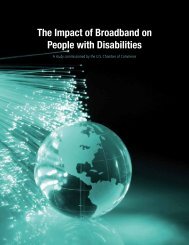



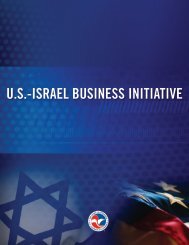
![[PDF] A Response by the International Organisation of Employers to ...](https://img.yumpu.com/41807569/1/184x260/pdf-a-response-by-the-international-organisation-of-employers-to-.jpg?quality=85)


